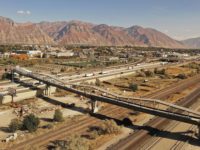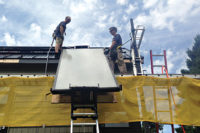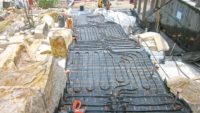A great many similarities exist between hydronic and electric snow-melt systems. The concept is simple: Input heat-energy, melt snow/ice and provide safe passage for people. As the old saying goes, the devil is in the details. In addition to the primary reason — people safety and avoiding liability — the secondary reason for snow-melt systems is the damage to concrete, bricks and landscaping caused by snow-melt chemicals and mechanical snow removal.
Designing snow-melt systems requires an accurate assessment of the intended construction of the area to be treated, the geographic area, physical property layout and runoff of melted snow/ice. It certainly helps to have programs such as Watts’ RadiantWorks Pro (download here).
The training provided by the Radiant Professionals Alliance long ago gave me a rock-solid foundation of essential knowledge for radiant hydronic and electric heating and snow-melt systems. Ongoing educational opportunities are available for beginners and professionals alike (visit the RPA site).
A corporate grand entrance snow-melt system I worked on encompassed several distinct, but joined-together areas: a lower sidewalk adjoining the driveway; a tapering stairway; an expansive upper-landing pad with multistory all-glass entrance; and to either side, ADA-sloped sidewalks that meet up with the lower sidewalk. In total, this is 2,465-sq. ft. of snow-melt.
Early on during the design phase, the owners of the corporate center decided the snow-melt system was to be electric. Future plans would incorporate a rooftop array of photovoltaic panels to generate electricity and more than offset the watts used to melt snow.
Communication is an essential part of any successful snow-melt project and Lucas Hann at Watts became an integral part of my team. Little did Hann or I know, in the beginning, how crucial his role was to become!
The general contractor needed to know how to properly slope the concrete pads for runoff of melted snow and ice to areas where no foot traffic would take place and directed to area drains. The construction crew needed to be educated about their responsibilities for protecting the installed snow-melt products and I needed to know exactly where the saw-cut joints would be so that our crew knew where to dive down with the Watts ProMelt cables to keep them out of harm’s way.
Exact specifications were reviewed on concrete thickness, the 2–in.-thick layer of brick pavers and how the pavers would be installed. The pavers were to be bonded to the concrete with high-density mortar for transferring heat energy effectively to the surface. Location for our vault where the cable leads would tie onto the circuits and precise location of our sidewalk snow-melt sensor were hashed out early on in the project so I could lay out the grid-pattern for the seven loops of 277-volt cables.
In order to enhance the snow-melt system’s capabilities by providing 50 watts (170 Btu/hr.) per sq. ft., all ProMelt cables were installed on 3-in. centers and gently attached to the 6-ft. by 6-ft. steel grid with plastic zip-ties. The grid was elevated by using plastic chairs to keep the electric snow-melt cables just 2 in. below the surface of the concrete pads. The snow-melt sensor’s housing was braced in place with layers of brick with an electrical conduit run from the sensor’s well to the electric vault.
We installed the Watts 200-amp, 277-volt control panel within the centrally located main electrical room located on an upper floor with conduits run from it to the outdoor below-grade vault. The electrical conduits were run above the first floor’s suspended ceiling and drywall-encased structural support beams provided a convenient chase for the final drop before drilling through the exterior below-grade wall. At the exterior vault, we had seven 277-volt lines joined as follows (amps): 19 + 19 = 38 x 1.25 (multiplier to provide required excess circuit ampacity per code) = 47.5; 19 + 19 = 38 x 1.25 = 47.5; 14.4 + 14.4 + 14.4 = 43.2 x 1.25 = 54. We provided three circuits: 50, 50 and 60 amps 277-volt. The snow-melt sensor has three wires required for its separate conduit.
Expect the unexpected
While on vacation with my family, I received a panicked email from the owner of the construction firm. The electrical inspector had been on site to inspect the lower sidewalk installation of our electric snow-melt cables. Several of the corporate center’s executives overseeing the project were on hand to hear the inspector state, as fact, that our snow-melt system would never work! As you might expect, this threw everyone into a tizzy and I was out of town. I lost a day of vacation while dealing with the issue.
The first step was finding out why the electrical inspector would shoot off his mouth while throwing us under the bus. As it turned out, he had incorrectly assumed the bricks would be laid over a bed of sand, which would have seriously degraded this, or any other, snow-melt system’s performance. Hann and I were on the hot-seat and Hann really came through for us during this artificial crisis. Had the inspector bothered to ask the general contractor, who was on site, he could have easily ascertained the construction details and learned the bricks were to be bonded to the concrete with mortar and the bricks were to be 2–in. thick.
But the electrical inspector didn’t stop there. He said we should have installed a three-phase snow-melt system instead of a single-phase system; a three-phase system would not cost as much to operate.
Hann responded: “Watts does not offer three-phase components for our electric systems. Keep in mind with an electric system based upon watts per sq. ft., the energy consumption will be the same whether it be 120VAC, 208VAC, 240VAC or 277VAC. Your energy bills are based upon kilowatt hours, so the only advantage is that higher voltage systems require a lower amp load to deliver the same amount of energy.”
Those inspector loose lips darn near scuttled the project.
The opera ain’t over until the fat lady sings! Once a seed of doubt is placed in an owner’s head, you never really get off the hot seat. That statement by the electrical inspector was a poltergeist that wouldn’t be exorcised until everyone within the corporation witnessed the snow-melt system operation result in snow- and ice-free sidewalks and stairs. Mother Nature cooperated early in the season with several dustings of snow but no blizzard. The owner let me know in no uncertain terms that I was on the hook until the system could be tested by a more severe snow storm.
A heavy wet snow settled in on Jan. 20 and I recorded surface temperatures over the entire area. On average, our snow-melt areas were 65° F. Outdoor air temperature was 35° at 3:30 p.m. and the untreated sidewalk adjacent to our snow-melt was 32°. During the blizzard, no snow had been able to accumulate — we were officially off the hook!
Whether a hydronic or electric snow-melt system, you need to include time in your bid to be on site during the concrete pour to ensure no one does anything that has the potential to damage your snow-melt products. The general contractor on this project was a pleasure to work with. For the upper landing area, the company constructed bridges to span the area for workers to handle the pumped-in concrete and work the concrete floats. It’s also a good — no, make that great — idea to incorporate costs to have on hand extra product just as a CYA (cover your ass-sets) in the event your tubing or cable is damaged during the pour.
This article was originally titled “Providing safety and avoiding liability” in the 2015 Radiant & Hydronics Report.
Author bio: Dave Yates began his career in the PHVAC trades in 1972. He purchased F.W. Behler, a third-generation PHVAC firm, in 1985. The company has won numerous awards for its work and Yates was the first recipient of the international Carlson-Holohan Industry Award of Excellence. A published author in numerous trade publications, he has served as an adjunct professor and served on the Technical Advisory Board for the Thaddeus Stevens College of Technology. Yates is a past executive board member of the Radiant Professionals Alliance and a member of the Green Mechanical Council.





